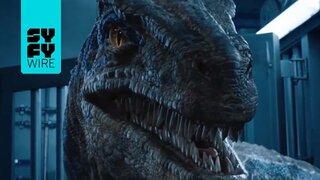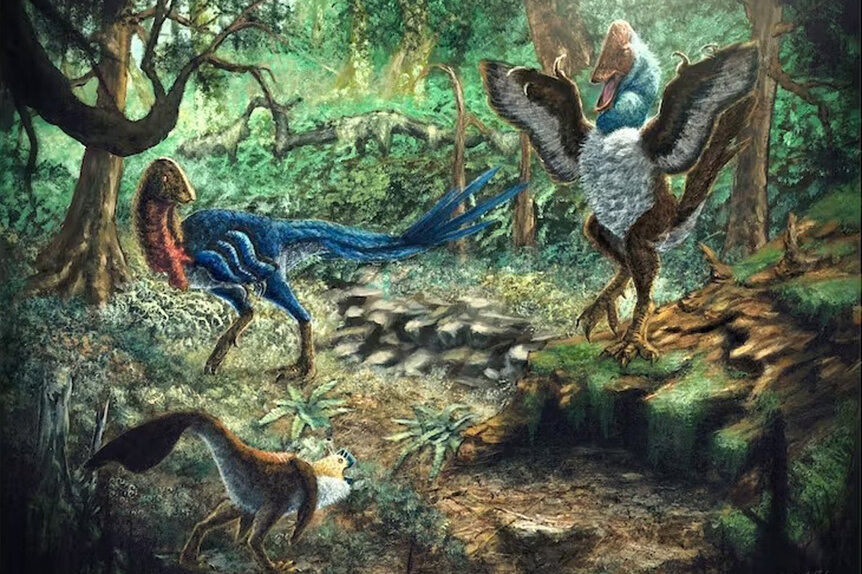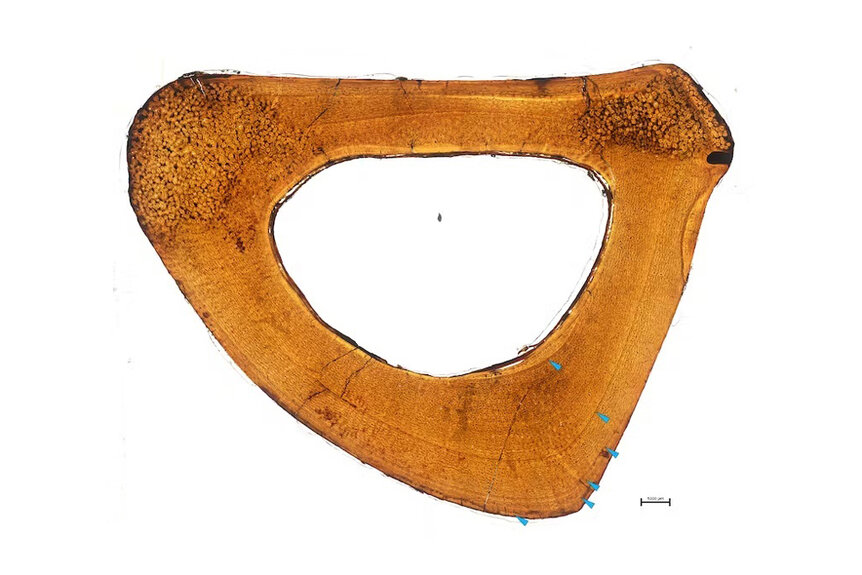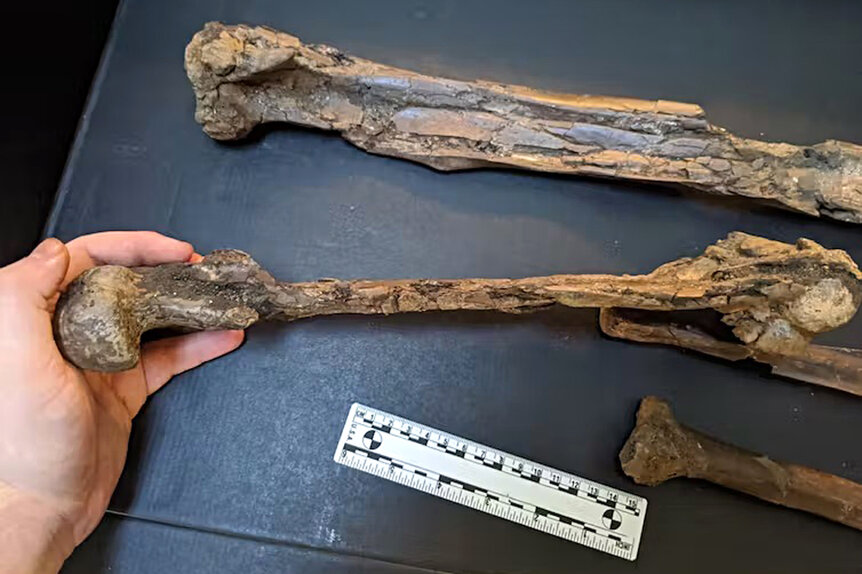Create a free profile to get unlimited access to exclusive videos, sweepstakes, and more!
Meet the Hell Chickens, A Newly Discovered Species of Birdlike Dinosaur
They sound scarier than they probably were.
Remember in Jurassic Park when Dr. Alan Grant (Sam Neill) scared the life out of a kid to prove a point? While happily describing the features of a fossil to a crowd of onlookers in the desert, an unnamed kid chirps up from the back, “That doesn’t look very scary. More like a six foot turkey.” Grant won’t stand for any dino disrespect, though, so he comes back with a little visualization exercise, one which ends with the kid’s guts spilling out around him while velociraptors eat him alive. Brutal.
“Six foot turkey” isn’t a great description for a velociraptor, but it’s not too far off from a recently discovered species of bird-like dinosaur lovingly known as a hell chicken. The new species, given the official name Eoneophron infernalis, was found in the Hell Creek formation, a site known for capturing the last couple million years leading up to the end of the Cretaceous. It provides a window into a narrow slice of time leading up to an extinction which killed all but the avian dinosaurs.
The Hell Chicken, a New Species of Dinosaur from the Hell Creek Formation
When paleontologists tally up all of the fossil species from this latter period and compare it to other sites from earlier periods, they’ve noted an apparent decrease in diversity. Some have suggested that this means dinosaurs were already on the decline, spiraling the drain toward evolutionary obscurity, when the asteroid showed up and finished the job. Others have suggested the apparent decrease in fossil dinosaurs is an artifact of how, when, and where animals fossilize.
This new species, when coupled with the potential discovery of a second new species, provides evidence that at least some dinosaur groups were doing just fine, even at the end. The study, published in the journal PLOS One, focuses on a group of bird-like dinosaurs called caenagnathids which inhabited Hell Creek between 68 and 66 million years ago.
For More on Dinosaurs:
We're Celebrating the Dinosaur Bicentennial in 2024
What Do Picky Tyrannosaur Kids Eat? Researchers Find Baby Dino Preserved with Last Meal
Some Dinosaurs Slept Like Modern Birds and It's Cute as Hell
The locality was already known for one caenagnathid species, Anzu Wyliei, and the new discovery raises the species' group population to at least two. “Anzu was the size of a grizzly bear in terms of weight,” Kyle Atkins-Weltman, lead author of the new study, told SYFY WIRE. “Our new species would have stood around waist height, but its neck was curved. It would have been able to look the average person in the eye.”
In addition to being smaller, Atkins-Weltman and colleagues noticed a few other differences. In particular, the head of the femur bent at a different angle and two of the ankle bones were fused in a way no one had ever seen before. Despite those differences, they initially thought they were looking at a young Anzu. It’s not uncommon to see dinosaurs go through significant morphological changes as they grow from adolescence to adulthood, but the story changed once they got a look inside the bones.
When researchers made thin slices of the bone and looked at them under a microscope, it became immediately clear they weren’t looking at a baby. Bones have growth rings similar to those inside trees. Every year, animals go through a period of arrested growth which marks the separation between rings, and you can tell how much they grew that year by the distance between those breakpoints. The microscope analysis showed that this particular dinosaur was between 6 and 7 years old, and that its rate of growth had slowed in recent years.
RELATED: New Mosasaur Species, Jormungandr the World Serpent, Found in North Dakota
“We know there can be considerable change in morphology throughout the life cycle of a single species, so I wanted to err on the side of caution. But when we got the histology results that are showing this animal was rapidly approaching its adult size, we started looking at all of the little differences in a completely different light,” Atkins-Weltman said.
If their animal wasn’t a juvenile, then it wasn’t an Anzu, which meant it must be something new. The team also found evidence (though it hasn’t been confirmed yet) of a third, smaller caenagnathid species at Hell Creek. When Anzu was first discovered, it was described as a “chicken from hell,” a reference to its bird-like features, large stature, and its discovery at the Hell Creek formation.
“They would have been incredibly bird-like. They were not officially in Avialae [the group containing living birds] but they were very close,” Atkins-Weltman said. “They were part of the group Pennaraptora, which have pennaceous feathers, feathers with an actual quill. They would have had full wings, a fan of tail feathers, and a toothless beak.”
The discovery of a second, and potentially a third, species at Hell Creek has prompted Atkins-Weltman to refer to the group as hell chickens, collectively. In addition to giving us some new “six foot turkey” to be fascinated by and scare mouthy kids with, the discovery also supports the idea that the dinosaurs were doing fine before the extinction event. In particular, researchers compared the caenagnathids at Hell Creek to those found at another, older locality dating to about 75 million years ago, and found no loss in diversity.
“When we looked at the Dinosaur Park formation which is from earlier, we see that there are three species of caenagnathid, one comparable in size to Anzu, one comparable in size to our new species, and one comparable in size to the third, smaller, proposed species. We’re seeing a lack of decrease in diversity,” Atkins-Weltman said. “We’re getting increasing evidence that there’s a lot more to be done to really understand the diversity of dinosaurs at the very end of the Cretaceous.”
See dinosaurs brought to life in Jurassic World Fallen Kingdom and Jurassic World Dominion, streaming now on Peacock. Or go back to the original with Jurassic Park, now available from Universal Pictures Home Entertainment.

































